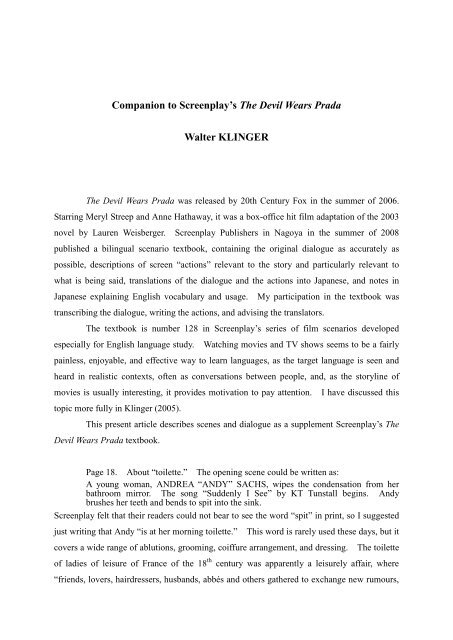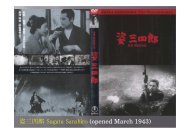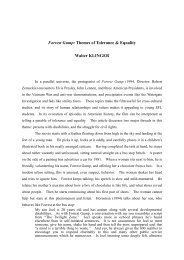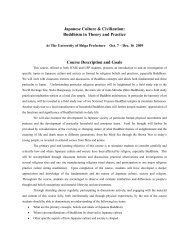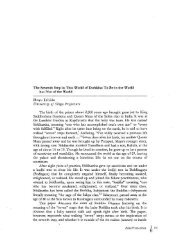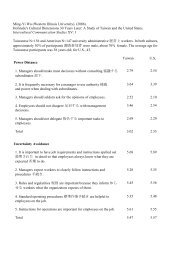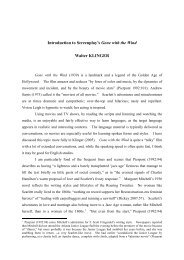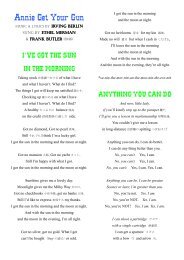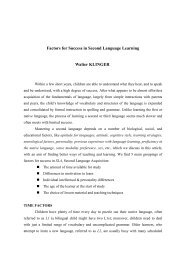wk08 Companion to Screenplay's The Devil Wears Prada
wk08 Companion to Screenplay's The Devil Wears Prada
wk08 Companion to Screenplay's The Devil Wears Prada
Create successful ePaper yourself
Turn your PDF publications into a flip-book with our unique Google optimized e-Paper software.
<strong>Companion</strong> <strong>to</strong> Screenplay’s <strong>The</strong> <strong>Devil</strong> <strong>Wears</strong> <strong>Prada</strong><br />
Walter KLINGER<br />
<strong>The</strong> <strong>Devil</strong> <strong>Wears</strong> <strong>Prada</strong> was released by 20th Century Fox in the summer of 2006.<br />
Starring Meryl Streep and Anne Hathaway, it was a box-office hit film adaptation of the 2003<br />
novel by Lauren Weisberger. Screenplay Publishers in Nagoya in the summer of 2008<br />
published a bilingual scenario textbook, containing the original dialogue as accurately as<br />
possible, descriptions of screen “actions” relevant <strong>to</strong> the s<strong>to</strong>ry and particularly relevant <strong>to</strong><br />
what is being said, translations of the dialogue and the actions in<strong>to</strong> Japanese, and notes in<br />
Japanese explaining English vocabulary and usage. My participation in the textbook was<br />
transcribing the dialogue, writing the actions, and advising the transla<strong>to</strong>rs.<br />
<strong>The</strong> textbook is number 128 in Screenplay‟s series of film scenarios developed<br />
especially for English language study. Watching movies and TV shows seems <strong>to</strong> be a fairly<br />
painless, enjoyable, and effective way <strong>to</strong> learn languages, as the target language is seen and<br />
heard in realistic contexts, often as conversations between people, and, as the s<strong>to</strong>ryline of<br />
movies is usually interesting, it provides motivation <strong>to</strong> pay attention. I have discussed this<br />
<strong>to</strong>pic more fully in Klinger (2005).<br />
This present article describes scenes and dialogue as a supplement Screenplay‟s <strong>The</strong><br />
<strong>Devil</strong> <strong>Wears</strong> <strong>Prada</strong> textbook.<br />
Page 18. About “<strong>to</strong>ilette.” <strong>The</strong> opening scene could be written as:<br />
A young woman, ANDREA “ANDY” SACHS, wipes the condensation from her<br />
bathroom mirror. <strong>The</strong> song “Suddenly I See” by KT Tunstall begins. Andy<br />
brushes her teeth and bends <strong>to</strong> spit in<strong>to</strong> the sink.<br />
Screenplay felt that their readers could not bear <strong>to</strong> see the word “spit” in print, so I suggested<br />
just writing that Andy “is at her morning <strong>to</strong>ilette.” This word is rarely used these days, but it<br />
covers a wide range of ablutions, grooming, coiffure arrangement, and dressing. <strong>The</strong> <strong>to</strong>ilette<br />
of ladies of leisure of France of the 18 th century was apparently a leisurely affair, where<br />
“friends, lovers, hairdressers, husbands, abbés and others gathered <strong>to</strong> exchange new rumours,
2 Walter KLINGER<br />
or <strong>to</strong> give old rumours new sparkle by a graceful turn of phrase” (Gay 1966). A number of<br />
artworks have the word “<strong>to</strong>ilette” in their titles, including works by Picasso, Beardsley,<br />
Toulouse-Lautrec, and Utamaro. <strong>The</strong> Free Library (2008) provides many instances from<br />
literature where the word appears; this example is from Charles Dickens‟ <strong>The</strong> Life and<br />
Adventures of Nicholas Nickleby:<br />
<strong>The</strong> great day arriving, the good lady put herself under Kate‟s hands an hour or so<br />
after breakfast, and, dressing by easy stages, completed her <strong>to</strong>ilette in sufficient time<br />
<strong>to</strong> allow of her daughter‟s making hers, which was very simple, and not very long,<br />
though so satisfac<strong>to</strong>ry that she had never appeared more charming or looked more<br />
lovely.<br />
<strong>The</strong> actual spitting is not seen in this scene; only the motion of bending over the sink<br />
followed by the sound. An interesting question is why this scene is in the film at all, as<br />
spitting doesn‟t seem <strong>to</strong> go well with an atmosphere of high fashion. Perhaps the<br />
filmmakers mean <strong>to</strong> confirm that Andy is not elegant and refined like the fashionistas, who<br />
surely do not do anything as vulgar as spit when a camera is on them. Perhaps it reflects<br />
some people‟s opinion of the fashion world; certainly, by the end of the s<strong>to</strong>ry, Andy decides it<br />
isn‟t for her. Perhaps the spitting is <strong>to</strong> reassure a type of man watching the movie with his<br />
female partner and is uncomfortable with the theme of the movie, fearing that it is just about<br />
women getting all excited about silly dresses, that he can look forward <strong>to</strong> some rather<br />
sophomoric laughs as well. Perhaps it is meant <strong>to</strong> confirm that Andy is not elegant, but a<br />
“regular” person who is about <strong>to</strong> be thrust in<strong>to</strong> an “abnormal” world. Perhaps it<br />
philosophically ponders that no matter how beautiful people may dress and adorn our bodies,<br />
human beings still perform biological functions that are not necessarily pleasant <strong>to</strong> view.<br />
<strong>The</strong> soundtrack song confirms what we see on the screen: You can see she’s a<br />
beautiful girl, she’s a beautiful girl, and sets one of the themes of the s<strong>to</strong>ry: Suddenly I see<br />
(Suddenly I see) This is what I wanna be, though the song actually is about the singer Patti<br />
Smith, and not about fashion models (Sunday Herald, 2005. Collis 2007). 1 Screenplay<br />
Publishers did not obtain the rights <strong>to</strong> publish the lyrics of the songs heard on the soundtrack,<br />
so the textbook rather unfortunately does not include any description of the songs and lyrics.<br />
Tunstall‟s song also somehow did not get included on the official movie soundtrack CD.<br />
Page 18. <strong>The</strong> date “Monday, March 13” in Andy‟s appointment book would make<br />
1 <strong>The</strong> Sunday Herald quotes Tunstall: “I wouldn‟t compare myself <strong>to</strong> Patti Smith. She‟s a<br />
post-punk poet really, which is not how I‟d describe myself. My song, Suddenly I See, is<br />
about Patti Smith.” Collis quotes Tunstall: “I didn‟t realize the lyrics could perfectly fit a<br />
chick flick, and it could sound like I was singing about wanting <strong>to</strong> be a f---ing model!”
<strong>Companion</strong> <strong>to</strong> Screenplay’s <strong>The</strong> <strong>Devil</strong> <strong>Wears</strong> <strong>Prada</strong> 3<br />
the year 2006. “Garbage piles grow as negotiations crumble: Jani<strong>to</strong>r‟s union won‟t budge”<br />
most certainly means the union is on strike, demanding more pay or better working conditions,<br />
so garbage is not being picked up. “Which Bus S<strong>to</strong>ps Here? More choices than ever for<br />
young students” probably refers <strong>to</strong> new bus lines coming in<strong>to</strong> or near the school. “NU<br />
Women Take Back the Night:” <strong>The</strong> expression “take back the night” is a slogan for s<strong>to</strong>pping<br />
violence against women; it doesn‟t have any other meaning. <strong>The</strong> idea is that criminals,<br />
especially rapists, have taken control of the night and made walking on the streets unsafe, so<br />
the anti-violence campaign intends <strong>to</strong> take the night back from the criminals.<br />
Page 18. <strong>The</strong> next scene can be described in more detail as follows:<br />
A street sign on the Lower East Side of Manhattan reads “ORCHARD ST.” <strong>The</strong><br />
appearance is of an old, working class neighborhood. A row of happy school<br />
children walk down the street. Andy comes out of her apartment, smiling and<br />
clutching her collar against the cold. <strong>The</strong> beautiful young women walk confidently<br />
out of their apartments in more upscale parts of <strong>to</strong>wn. An elegant hand measures a<br />
small amount of cereal in<strong>to</strong> a Pyrex measuring cup next <strong>to</strong> small bowls of yogurt and<br />
fruit. Someone wearing a severely elegant bracelet counts a small number of<br />
almonds in<strong>to</strong> a bowl. Someone at a s<strong>to</strong>re counter hands a bagel sandwich <strong>to</strong> a<br />
cus<strong>to</strong>mer. A sign says “Bakery” and Andy comes out of the shop, eating the bagel.<br />
<strong>The</strong> young women leisurely hail taxis and step in<strong>to</strong> cars. Andy hurries <strong>to</strong> a subway<br />
entrance and down the stairs. She then walks in a busy business area and looks up<br />
at the skyscrapers. She goes in<strong>to</strong> a building lobby a bit apprehensively and over <strong>to</strong><br />
the information desk. A sign on the wall says “elias-clarke publications” in<br />
lower-case letters.<br />
This scene again contrasts the difference in the lifestyles of Andy and the beautiful girls. A<br />
little mistake in continuity occurs here: when Andy is running across the street <strong>to</strong> the subway<br />
entrance, she doesn‟t have the bagel; but, when she is going down the stairs, she‟s eating the<br />
bagel again. I think a New Yorker would most likely come in<strong>to</strong> the elias-clarke building<br />
directly from the subway, without going outdoors; but, that wouldn‟t be especially cinematic,<br />
and it wouldn‟t have established the setting for Miranda‟s arrival in her car. <strong>The</strong><br />
unconventional lower-case letters of the publisher‟s name, elias-clarke, on the lobby wall<br />
confirms that this is a pretty hip place.<br />
Page 20. Emily tells Andy, “A million girls would kill for this job.” This tag-line<br />
is repeated several times in the s<strong>to</strong>ry. Page 30, Doug: “I bet a million girls would just kill for<br />
that job.” Page 50, Ravitz: “A million girls would kill for that job.” Page 70, Nigel: “this<br />
place, where so many people would die <strong>to</strong> work, you only deign <strong>to</strong> work” (here, “die” is<br />
nicely alliterated with “deign”). Page 138, Nigel: “We‟re <strong>to</strong>asting, my dear, <strong>to</strong> the dream job.<br />
<strong>The</strong> one that a million girls wanted.”
4 Walter KLINGER<br />
Page 22. “Gird your loins” means “Prepare for some difficult and dangerous<br />
action,” “Prepare for the worst” or “Prepare <strong>to</strong> defend yourself.” It appears several times in<br />
the Old Testament Bible:<br />
-- She girdeth her loins with strength, and strengtheneth her arms. (Proverbs 31:17)<br />
-- <strong>The</strong>n the hand of the LORD was on Elijah, and he girded up his loins and outran Ahab<br />
<strong>to</strong> Jezreel. (1 Kings 18:46)<br />
-- <strong>The</strong>n he said <strong>to</strong> Gehazi, “Gird up your loins and take my staff in your hand, and go<br />
your way; if you meet any man, do not salute him, and if anyone salutes you, do not<br />
answer him; and lay my staff on the lad‟s face.” (2 Kings 4:29)<br />
-- “Now gird up your loins like a man, And I will ask you, and you instruct Me!” (Job<br />
38:3)<br />
<strong>The</strong> original reference of gird is <strong>to</strong> tuck up one‟s long and loose robe in<strong>to</strong> one‟s belt<br />
so that the robe would not hamper physical movement. “Loins” also loosely refers <strong>to</strong> human<br />
genitals due <strong>to</strong> their prominence in the ana<strong>to</strong>mical region known as the loins; hence, “fruit of<br />
one‟s loins” means one‟s children. Using the expression in any everyday situation creates a<br />
humorous effect, both because it is so archaic and because it is a euphemism for sexual<br />
organs.<br />
American movie theater audiences laugh loud at Nigel‟s line here; no doubt because<br />
they are taking sophomoric delight in the ribaldry of the phrase, but also perhaps because it is<br />
Nigel who delivers the line. Nigel, as he works in the fashion business, can be assumed <strong>to</strong><br />
be gay; besides, he seems <strong>to</strong> be excessively fastidious in grooming, certainly compared with<br />
perpetually grubby and clearly heterosexual Nate. Thus the audience may be expecting<br />
Nigel <strong>to</strong> be witty and campy, if not completely outrageous, and are expressing their delight. 2<br />
Pages 22-24. Miranda‟s entrance, her narcissistic attitude, devastating insults, and<br />
uns<strong>to</strong>ppable delivery are also quite humorous. <strong>The</strong> shots of people scurrying <strong>to</strong> avoid<br />
crossing her path provoke chuckles, and Miranda talking full-tilt and non-s<strong>to</strong>p <strong>to</strong> Emily<br />
reminds me of Dorothy‟s first appearance in <strong>The</strong> Wizard of Oz, where Dorothy‟s words<br />
literally gush out of her mouth as she urgently informs Aunt Em and Uncle Henry about Miss<br />
Gulch.<br />
Page 26. Andy steps in<strong>to</strong> Miranda‟s office and Miranda asks, “Who are you?”<br />
<strong>The</strong> DVD subtitles say 名前は? (Your name?). This is obviously not a good translation, as<br />
we soon find out that Miranda is not interested in learning her assistants‟ names, at least not<br />
until they have proven themselves worthy of acknowledgement. I imagine what Miranda<br />
2 Any of those expectations are not fulfilled, as Nigel is not at all portrayed as over-the-<strong>to</strong>p,<br />
flamboyantly swishy and queeny, and he doesn‟t have any more funny lines. <strong>The</strong>re is a hint<br />
that he may make a risqué joke when he describes Irv Ravitz <strong>to</strong> Andy in the eleva<strong>to</strong>r, but he<br />
s<strong>to</strong>ps short.
<strong>Companion</strong> <strong>to</strong> Screenplay’s <strong>The</strong> <strong>Devil</strong> <strong>Wears</strong> <strong>Prada</strong> 5<br />
wants <strong>to</strong> hear in reply <strong>to</strong> her question is Andy‟s background and experience, and, hopefully,<br />
hear the name of someone famous or someone she knows so she can make a mental<br />
connection and an evaluation. <strong>The</strong> Screenplay translation of あなたは? (Yes? You wanted<br />
something? / Yes? Who are you?) is closer <strong>to</strong> Miranda‟s personality and intent.<br />
Page 26. Similarly, Miranda asks, “And what are you doing here?” which is poorly<br />
translated in the DVD subtitles as で、ここでどんな仕事をしたいの. (And, what kind of<br />
work do you want <strong>to</strong> do here?) <strong>The</strong> Screenplay translation で、どうしてここに来たの?<br />
(And, why have you come here?) is more accurate. Miranda is not asking what job Andy<br />
wants <strong>to</strong> do; Emily has already <strong>to</strong>ld her that Andy has come for the assistant position.<br />
Miranda has already sized up Andy and seen her as unfashionable and unsuitable for the job;<br />
her question can be unders<strong>to</strong>od as being rather rude.<br />
Page 26. Miranda‟s classic dismissal, “That‟s all” can perhaps best be translated as<br />
以上よ. (That‟s all.) However, the Japanese expression is commonly used and has no<br />
particular nuance of impoliteness; but, in English, “That‟s all” sounds quite abrupt. A more<br />
polite expression would be something longer, i.e., “That‟s all for now.” I have often heard<br />
Japanese speakers saying “That‟s all” when they come <strong>to</strong> the end of their speeches or<br />
presentations in English; I recommend instead, “That‟s the end of my speech,” “I have come<br />
<strong>to</strong> the end of my presentation,” or “That‟s all I have <strong>to</strong> say; Thank you.” 3<br />
Page 36. “She now works at TV Guide.” <strong>The</strong> implied meaning is that Miranda<br />
destroyed the woman‟s reputation so that the only job she could get was at the relatively<br />
unprestigious and quotidian weekly magazine, TV Guide. We can imagine that fashionistas<br />
probably will not willingly admit <strong>to</strong> watching plebian television at all.<br />
Page 44. <strong>The</strong> plural of scarf is usually scarves, but it is sometimes spelled scarfs,<br />
reflecting the alternative pronunciation. <strong>The</strong> plural of leaf is usually leaves, but an exception<br />
is the sports team, the Toron<strong>to</strong> Maple Leafs.<br />
Page 44. Cassidy is one of Miranda‟s twin daughters. <strong>The</strong> name of the other<br />
daughter is given as Caroline in the novel, though Caroline‟s name is never heard in the film.<br />
Page 46. It is unclear if Serena is Runway staff or just a friend of Emily‟s dropping<br />
by; however, Direc<strong>to</strong>r David Frankel on the DVD commentary track mentions that<br />
supermodel Gisele Bündchen agreed <strong>to</strong> be in the movie only if she didn‟t play a model.<br />
Page 48. “Not since two became the new four and zero became the new two.”<br />
3 Forrest Gump‟s catchphrase is “That‟s all I have <strong>to</strong> say about that.”
6 Walter KLINGER<br />
Nigel means that if you wear size 2, people look at you as if you are size 4. In other words,<br />
the ideal figure now is slimmer. <strong>The</strong>re is a phenomenon that clothes sizes are getting smaller<br />
for some brands. Consumers have reported (Fasanella 2005) that they bought clothes at the<br />
Gap and Banana Republic some years earlier, but when they try on the same size now, the<br />
clothes are <strong>to</strong>o big, and they have <strong>to</strong> try on smaller sizes. <strong>The</strong> phenomenon may be called<br />
“vanity sizing,” where clothes are labeled as being a smaller size than they really are, so that<br />
buyers will be flattered, thinking that they are slimmer than they really are.<br />
Page 50.<br />
Nigel walks away and Andy runs after him. A woman ahead of Nigel turns aside.<br />
NIGEL: (v.o.) Excuse me!”<br />
I don‟t think it is Nigel who says this. <strong>The</strong> woman (in a white <strong>to</strong>p) has already moved away<br />
from Nigel before he says “excuse me;” moreover, she is rather far away from him, so there is<br />
no reason for Nigel <strong>to</strong> say “excuse me” <strong>to</strong> anyone. I think the correct Action and Dialogue<br />
should read as:<br />
<strong>The</strong> cashier protests Andy abandoning her tray in the line.<br />
CASHIER‟S VOICE :: (v.o.) Excuse me!<br />
Just before Nigel gets his phone call, you can see the “T” shape of a cash register<br />
(which displays how much you need <strong>to</strong> pay), and you can see a hand by the T, which must be<br />
the cashier‟s hand. You can also hear the sound of the cashier ringing up amounts. Nigel<br />
only picks up Andy‟s soup from her tray and throws away the soup, but Andy‟s tray is still on<br />
the rail. Andy runs after Nigel, so she obviously is leaving her tray behind, on the rail. So,<br />
I am sure the “excuse me” must be the cashier‟s voice, angry that Andy is abandoning her tray<br />
just in front of him. Americans are not known for taking abuse without protest; I don‟t<br />
believe the cashier would be silent in this situation, let alone a cashier in a place where all the<br />
employees are quite capable of being catty, nasty, and testy.<br />
Screenplay decided <strong>to</strong> follow the script according <strong>to</strong> the Final Dialogue List, which is<br />
a scenario provided by the copyright agency. <strong>The</strong> FDL shows the dialogue arranged by time<br />
coding, accompanied by notes that explain some of the actions and some unusual English<br />
vocabulary and expressions, apparently for the use of international transla<strong>to</strong>rs for captioning<br />
and subtitling. It is not clear who wrote the FDL. <strong>The</strong> FDL of DWP very adequately<br />
explains who the various designers mentioned in the script are; but, it inevitably does not<br />
explain all of the language usages heard in the film (e.g, “back of the issue,” “by all means,”
<strong>Companion</strong> <strong>to</strong> Screenplay’s <strong>The</strong> <strong>Devil</strong> <strong>Wears</strong> <strong>Prada</strong> 7<br />
and “ask of me”). <strong>The</strong> FDL also sometimes doesn‟t really explain (e.g., it explains “for<br />
crying out loud” as “colloquial emphatic phrase”), and sometimes doesn‟t explain well (e.g.,<br />
“death warmed up: British variation of „death warmed over‟, a colloquial expression meaning<br />
„ill and exhausted,‟” and “gatekeeper: one who moni<strong>to</strong>rs or oversees the actions of others”).<br />
At times, it is completely wrong, e.g., “After the banquet, Andy gets in the <strong>to</strong>wn car with<br />
Miranda - it drives off.” In fact, Andy gets in<strong>to</strong> the car alone; Miranda is not in it.<br />
I would have <strong>to</strong> say the FDL is wrong in saying it is Nigel speaking here. <strong>The</strong>re is<br />
one potential explanation why Nigel might be credited as saying “Excuse me!,” and that is<br />
that if the Cashier were credited with speaking, the ac<strong>to</strong>r playing the Cashier would have <strong>to</strong> be<br />
paid more than for a non-speaking part.<br />
Page 54. “Oscar De la Renta” should be “Oscar de la Renta.” Same on page 70,<br />
“Hals<strong>to</strong>n, Lagerfeld, De la Renta” should be “Hals<strong>to</strong>n, Lagerfeld, de la Renta.”<br />
Page 56. “That is why those girls are so skinny.” <strong>The</strong> novel (Weisberger<br />
2003:164) explains further:<br />
Or was it just the adrenaline and nerves mixing <strong>to</strong>gether <strong>to</strong> guarantee no appetite?<br />
That was it! <strong>The</strong> starvation so endemic at Runway was not, in fact, self-induced; it<br />
was merely the physiological response of bodies that were so consistently terrified<br />
and all-around anxiety-ridden that they were never actually hungry.<br />
<strong>The</strong> novel also describes, “Runway fashion assistants on their way <strong>to</strong> pick up the cigarettes,<br />
Diet Coke, and mixed greens that would constitute their lunch” (Weisberger 2003:188).<br />
Present day Hollywood movies do not often show people smoking.<br />
Page 56. “Tiger” is rather an affectionate term of address, as tigers can have a<br />
sweet, cuddly image, like the characters “Tigger” in Disney‟s Winnie-the-Pooh; “Hobbes”<br />
from the car<strong>to</strong>on strip Calvin and Hobbes; and “Tony the Tiger,” the mascot for Kellogg‟s<br />
Frosted Flakes breakfast cereal, whose catchprase is “<strong>The</strong>y‟re grrr-ate!” <strong>The</strong> Hanshin Tigers<br />
baseball team also has a rather loveably fierce image.<br />
Page 60. Andy‟s father‟s name is Richard Sachs in the end credits, though his name<br />
is not mentioned in the movie. <strong>The</strong> extras in the restaurant, the Kraft Restaurant on 42 nd St.,<br />
where Andrea has dinner with her father, were winners of a contest for American Express<br />
cardholders.<br />
Page 64. “Nothing is flying out” means “Nothing is flying out of Miami.” Similarly,<br />
“fly in” means fly in <strong>to</strong> Miami.<br />
Page 68. “I had hope. My God, I live on it.” Miranda is not just saying she<br />
hoped Andy would be a good assistant; but, that the concept of hope is central <strong>to</strong> her entire
8 Walter KLINGER<br />
philosophy of life. Hope is the theme of many memorable quotes:<br />
We live by admiration, hope and love. -- William Wordsworth<br />
I know that you can‟t live on hope alone, but without it, life is not worth living. --<br />
Harvey Milk<br />
We should not let our fears hold us back from pursuing our hopes. -- John F. Kennedy<br />
Every time you stand up for an ideal, you send forth a tiny ripple of hope. -- Robert F.<br />
Kennedy<br />
We must accept finite disappointment, but never lose infinite hope. -- Martin Luther<br />
King, Jr.<br />
Never talk defeat. Use words like hope, belief, faith, vic<strong>to</strong>ry. -- Norman Vincent Peale<br />
<strong>The</strong> miserable have no other medicine but only hope. --William Shakespeare<br />
In all things it is better <strong>to</strong> hope than <strong>to</strong> despair. -- Johann Wolfgang von Goethe<br />
Page 72. “And... shoes... Jimmy Choos.” <strong>The</strong> novel (Weisberger 2003:188) has a<br />
great line about shoes:<br />
“Ahn-dre-ah?”<br />
“Yes, Miranda?”<br />
“Whose shoes are you wearing?<br />
“Um, mine?” I said, without realizing until the words had been spoken that it sounded<br />
not only disrespectful, but downright obnoxious.<br />
Page 76. In the novel (Weisberger 2003:37), Emily is unwrapping presents sent <strong>to</strong><br />
Miranda for Christmas, one of which is a Bang and Olufsen phone:<br />
“A phone? Do you believe someone had the nerve <strong>to</strong> send Miranda Priestly a phone?”<br />
She <strong>to</strong>ssed it <strong>to</strong> me. “Keep it if you want it: I would never even let her see this.<br />
She‟d be annoyed that someone sent something electronic.”<br />
Page 78.<br />
LILY : “Oh, no, no, no. This bag is, like, nineteen hundred dollars. I cannot take this<br />
from you. Ah!”<br />
Lily is protesting, but at the same time, she is transferring her things in<strong>to</strong> the new bag.<br />
Everyone laughs.<br />
ANDY : “Yeah, you can.”<br />
Andy‟s reply is not really ええ、いいのよ (Yeah, it‟s fine.) but more like もらえないと言<br />
っているのにやっぱりもらえているね。(You say you can‟t take it, but you obviously are<br />
taking it.)<br />
Page 82. “He is freelance writer Christian Thompson.” It may seem that an article<br />
“a” is needed here → “He is a freelance writer, Christian Thompson.” However, the article<br />
is not needed.<br />
Explanation #1. American English often regards job descriptions as a kind of title,<br />
parallel <strong>to</strong> titles that typically do not take articles, like “Queen,” “Doc<strong>to</strong>r,” and “Professor.”<br />
This style is especially widely used in journalism, in newspapers, magazines, and television.
<strong>Companion</strong> <strong>to</strong> Screenplay’s <strong>The</strong> <strong>Devil</strong> <strong>Wears</strong> <strong>Prada</strong> 9<br />
E.g., “Yesterday, we met magazine edi<strong>to</strong>r Miranda Priestly.” “Magazine edi<strong>to</strong>r Miranda<br />
Priestly said she will retire next year.” “How tall is ac<strong>to</strong>r Tom Cruise?” “Ac<strong>to</strong>r Tom<br />
Cruise‟s real name is Thomas Cruise Mapother.”<br />
I think one reason this style may be widely used is because it saves on reading and<br />
thought processing time; for, if an article is used, a comma --and thus a mental pause-- would<br />
be necessary, like this: “He is a freelance writer, Christian Thompson.” and “Yesterday we<br />
met the magazine edi<strong>to</strong>r, Miranda Priestly.” Another reason may be that it is also often<br />
difficult <strong>to</strong> decide if “a” or “the” should be used, so using neither article is a convenient<br />
solution.<br />
Explanation #2. Dropping the article has an established precedent in the rule of<br />
“Defining by Referencing.” When the subject is referenced with a list of alternate nouns,<br />
you can chose <strong>to</strong> use or omit the article. For example, compare these two sentences:<br />
(i) John, doc<strong>to</strong>r, artist and writer, arrived later than everyone else.<br />
(ii) John, a doc<strong>to</strong>r, an artist and a writer, arrived later than everyone else.<br />
Sentence (i) is clearer in identifying that just one person arrived later, since (ii) could<br />
refer <strong>to</strong> four people. <strong>The</strong> same rule, that the article is optional, applies if the reference is a<br />
noun phrase (adapted from Johnson n.d.):<br />
(a) John, veteran of many difficult situations, was nevertheless nervous about this one.<br />
(b) John, a veteran of many difficult situations, was nevertheless nervous about this one.<br />
(x) Rebel without a cause, John often picked pointless fights.<br />
(y) A rebel without a cause, John often picked pointless fights.<br />
Because Christian is himself a journalist, I think he would also omit the article here.<br />
Page 93. “She bring the Boock upstairs all the time?” This sentence was slipped<br />
in<strong>to</strong> the textbook after my final proofreading; obviously, it should be, “She brings the Book<br />
upstairs all the time?”<br />
Page 94. <strong>The</strong> “tri-state area” for New York City means the three states of New York,<br />
New Jersey, and Connecticut.<br />
Page 97. More about the use of “copy:” When Andy says, “I‟m not gonna get a<br />
copy of that book,” it is not at all clear whether she means “copy” in the sense of the counter<br />
for books or in the sense of a pho<strong>to</strong>copy. Because the book is not yet printed, all “copies”<br />
must be “pho<strong>to</strong>copies.” If the book were already published, I would almost never feel that
10 Walter KLINGER<br />
“copy” means a pho<strong>to</strong>copy. When a sentence uses “copy” as a noun, and says “get” or<br />
“have” a copy of a book or a magazine or a newspaper, I feel no nuance of “pho<strong>to</strong>copy”<br />
because those items have a lot of pages, so it would be a lot of trouble <strong>to</strong> pho<strong>to</strong>copy them, and<br />
also I would wonder why anyone would want <strong>to</strong> pho<strong>to</strong>copy so many pages. If the sentence<br />
says “get” or “have” a copy of a newspaper article, I feel it could very well mean pho<strong>to</strong>copy<br />
because (1) an article is not published by itself, and (2) it can easily be pho<strong>to</strong>copied in just<br />
one or two pages.<br />
<strong>The</strong> original use of “copy” comes from the age before the printing press, when all<br />
books had <strong>to</strong> be copied by hand, word by word, in ink. So, all books were copies, or<br />
duplicates. Even <strong>to</strong>day, all books are still copies of one original book. In modern English,<br />
“copy” is used in the sense of “pho<strong>to</strong>copy” mostly when the word is used as a verb, “<strong>to</strong> copy,”<br />
or when another verb describes the action, like “<strong>to</strong> make a copy.”<br />
This is a particular problem for Japanese learners of English, as Japanese uses<br />
different words for noun and verb. “Copy” as a verb usually is コピーする, with コピー<br />
simply the transliterated English word “copy,” while “copy” as a noun, used as a counter for<br />
large items like books, newspapers, and magazines that have many bound pages, is the<br />
pic<strong>to</strong>gram 冊. A student in a small language school came in<strong>to</strong> my English class once<br />
without a textbook. I <strong>to</strong>ld her, “Go <strong>to</strong> the reception desk and get a copy,” meaning she<br />
should get a copy of the dozen or so copies of the textbook available for student use. <strong>The</strong><br />
student seemed <strong>to</strong> be taking an awful long time in returning <strong>to</strong> the classroom; when I went <strong>to</strong><br />
check, I found her and the receptionist pho<strong>to</strong>copying the book. I think careful writers and<br />
speakers of English will try <strong>to</strong> say “pho<strong>to</strong>copy” or “xerox” when the meaning might not be<br />
clear; certainly, I learned that lesson.<br />
Andy is perhaps using “book” incorrectly; she should say “manuscript,” but even<br />
then it would not be clear if “copy” is a counter or a pho<strong>to</strong>copy. Christian refers twice <strong>to</strong><br />
“the manuscript;” but, even though he says “the,” it is not at all certain that he means “the<br />
only one,” because there surely are at least two or three pho<strong>to</strong>copies, or otherwise duplicated<br />
copies, of the manuscript (the art edi<strong>to</strong>r Christian knows has one, the publisher surely has one,<br />
J.K. Rowlings must have the original.)<br />
Page 98. <strong>The</strong> poster on the bus reads, “ONLY IN “NEW YORK.” SHAKESPEARE<br />
IN THE PARKING LOT. Homeless Hamlet off Hous<strong>to</strong>n Street. By Christian Thompson.”<br />
This refers <strong>to</strong> an article in “New York” magazine, perhaps about an amateur drama production
<strong>Companion</strong> <strong>to</strong> Screenplay’s <strong>The</strong> <strong>Devil</strong> <strong>Wears</strong> <strong>Prada</strong> 11<br />
by homeless people, or perhaps about a talented homeless person. <strong>The</strong> title features a nice<br />
alliteration of the “h” sound, with Homeless, Hamlet, and Hous<strong>to</strong>n.<br />
Page 102-3. “Miranda swivels back <strong>to</strong> the desk and takes the coffee.” I wasn‟t<br />
able <strong>to</strong> describe her expression, so I only described the physical action. Meryl Streep‟s<br />
acting is quite inscrutably wonderful here; but, it seems an expression of displeasure at<br />
something. <strong>The</strong>re is a strong sound of her hand snatching the coffee cup; perhaps the rather<br />
unexpected development of Andy successfully getting the impossible-<strong>to</strong>-get manuscript made<br />
Miranda forget for just a moment that her coffee was waiting for her, and when she<br />
remembered, she became angry at herself for not completely in control and aware of<br />
everything. Or, she may be unhappy that she will not have the pleasure of callously firing<br />
Andy for failing <strong>to</strong> accomplish her impossible demand.<br />
magazine.<br />
Page 106. “Back of the issue” probably means the last several pages of the<br />
Page 108. Miranda says, “the Supreme Court women... woman.” She says<br />
“woman” with a rather disgusted <strong>to</strong>ne and look, meaning that she thinks there really should be<br />
women, not just one woman, on the Court. <strong>The</strong>re were two female justices -- Sandra Day<br />
O‟Connor and Ruth Ginsberg, but when O‟Connor retired in 2005, she was replaced with a<br />
man, Samuel Ali<strong>to</strong>, Jr. *This edi<strong>to</strong>rial conference scene is not in the novel, which sees only<br />
through Andy‟s eyes.<br />
Page 110. “An incubus of viral plague” is a vivid expression, but more logically the<br />
phrase should be “an incuba<strong>to</strong>r of viral plague.”<br />
Page 112. “Andy sees a Galliano gown that Nigel is holding up.” <strong>The</strong> DVD<br />
commentary track mentions the designer.<br />
Page 124. “Front glass” doesn‟t have any meaning at all in English. However, used<br />
in context, it is readily understandable as “windshield.” “Japanese English” words for car<br />
parts are actually often quite pithy, like “back mirror,” “side brake” and “punk.”<br />
Page 124. “A red-hot poker” and “you sold your soul.” Finally we have a spoken<br />
reference <strong>to</strong> the Ruler of Hell as promised in the title. Red is the color of the <strong>Devil</strong>, his<br />
pitchfork, and the flames of Hell, so we can identify Miranda as the personification of the<br />
<strong>Devil</strong> as soon as we see her red shoes coming out of the car in her first appearance. Her<br />
heels in that scene are not sharp stilet<strong>to</strong>s that will surely pierce your soul, but are solid, bulky<br />
ones that look like they will surely crush your soul. “Sell your soul” is quite equivalent <strong>to</strong>
12 Walter KLINGER<br />
the more contemporary “drink the Kool-Aid.”<br />
Page 126. It isn‟t clear at all why Andy says Doug is scaring her because he knows<br />
the name of the relatively obscure designer. She is more likely surprised than scared, but<br />
even being surprised would show that she doesn‟t seem <strong>to</strong> know much about her supposedly<br />
good friend‟s interests. I think as well that Lilly doth protest <strong>to</strong>o much over Christian‟s quite<br />
chaste peck on the check.<br />
Page 128. Nate must be perpetually in casual wear and unshaven so that the<br />
boyfriends of the chick flic fans can have at least one character in the movie that they can<br />
identify with.<br />
Page 132. Supermodel Heidi Klum is in the crowd, as are Valentino‟s business<br />
partner, Giancarlo Giammetti, his majordomo Carlos de Souza, and his muse, Charlene Shor<strong>to</strong><br />
de Ganay. <strong>The</strong> Interviewer is portrayed by fashion reporter Robert Verdi.<br />
Page 134. “<strong>The</strong> boyfriend non plus?” Christian‟s French is rather substandard; I<br />
think he might be trying <strong>to</strong> say “<strong>The</strong> boyfriend is no longer the boyfriend?” so he better say<br />
“<strong>The</strong> boyfriend ne plus?” Similarly, on page 144, Christian says <strong>to</strong> Andy, “Bonjour,<br />
madame” when he really should be saying “mademoiselle.” He is perhaps not intentionally<br />
being ignorant, unless he is implying something about their relationship, but the difference<br />
between madame and mademoiselle is a quite basic vocabulary item.<br />
Page 134. <strong>The</strong> hotel room scene was filmed in the New York St. Regis Hotel<br />
Presidential Suite. Meryl Streep did not go <strong>to</strong> Paris for the two days spent filming there.<br />
Page 134. <strong>The</strong> mention of Snoop Dogg is quite funny by being rather incongruous;<br />
although, some rap stars are indeed no<strong>to</strong>rious for their conspicuous consumption of luxury<br />
brand-name products or flashy “bling.”<br />
Page 136. Streep‟s delivery is brilliant: “Another Father… (she pauses <strong>to</strong> consider,<br />
and decides that Stephen was not really a father, just a metaphorical one, so she adds a<br />
qualifying word) …Figure … (she chuckles slightly at her own wit, or the absurdity of the<br />
situation) … gone (she combines a chuckle and sigh). Anyway, the point is … (she clears<br />
her throat) ... the point is (she sighs deeply), the point is, we really need <strong>to</strong> figure out where <strong>to</strong><br />
place Donatella, because she‟s barely speaking <strong>to</strong> anyone (she has the delivered the punch line,<br />
a non sequitur).” *<strong>The</strong> real-life Donatella Versace was rather no<strong>to</strong>rious for her tantrums.<br />
Page 138. “Can you imagine?” means “Can you imagine what a disaster it would<br />
be if Miranda hadn‟t been <strong>to</strong>ld about it?”
<strong>Companion</strong> <strong>to</strong> Screenplay’s <strong>The</strong> <strong>Devil</strong> <strong>Wears</strong> <strong>Prada</strong> 13<br />
Page 140. “And not, not in a good way.” Christian is jokingly implying that some<br />
people would consider a little bit of sadism <strong>to</strong> be enjoyable.<br />
Page 142. Author Weinberger worked at Vogue Magazine as an assistant <strong>to</strong><br />
edi<strong>to</strong>r-in-chief Anna Win<strong>to</strong>ur; twice in her novel she tries <strong>to</strong> make it clear that Miranda is not<br />
really Anna:<br />
<strong>The</strong>re was a small, elegant s<strong>to</strong>ne patio in the back of the <strong>to</strong>wnhouse, all lit by white<br />
candles, where a violinist played softly, and I peeked outside. Immediately I recognized<br />
Anna Win<strong>to</strong>ur, looking absolutely ravishing in a cream-colored silk slip dress and beaded<br />
Manolo sandals. She was talking animatedly <strong>to</strong> a man I presumed <strong>to</strong> be her boyfriend,<br />
although her giant Chanel sunglasses prevented me from being able <strong>to</strong> tell if she was<br />
amused, indifferent, or sobbing. <strong>The</strong> press loved <strong>to</strong> compare the antics and attitudes of<br />
Anna and Miranda, but I found it impossible <strong>to</strong> believe that anyone could be quite as<br />
unbearable as my boss. (p. 245)<br />
“Of course, I have now been fired by the most powerful woman in publishing. Not only<br />
do I not have a way <strong>to</strong> pay off my nearly maxed-out MasterCard, but future jobs in<br />
magazines are looking rather dismal. Maybe I should try <strong>to</strong> work for one of her enemies?<br />
<strong>The</strong>y‟d be happy <strong>to</strong> hire me, right?” “Sure. Send your resume over <strong>to</strong> Anna Win<strong>to</strong>ur --<br />
they‟ve never liked each other very much.” (p. 265)<br />
Page 144. “Miranda will be devastated. Her whole life is about Runway. He can‟t<br />
do that <strong>to</strong> her.” While the novel Miranda is unrelentingly mean, the film Miranda manages<br />
<strong>to</strong> win some sympathy from the audience, and even from Andy.<br />
Page 148. “Runway and James Holt share many things in common, chief among<br />
them, a commitment <strong>to</strong> excellence.” <strong>The</strong> implication is that they also share “good taste in<br />
design,” “talent,” “creativity,” and “imagination.” Miranda and James also apparently share<br />
an ability <strong>to</strong> stay in power by whatever means necessary.<br />
Page 150. “Truth is, there is no one that can do what I do. Including her. …<br />
Especially because of the list” This means that, in effect, Miranda didn‟t have <strong>to</strong> give<br />
Nigel‟s job <strong>to</strong> Jacqueline after all, because Irv could not really replace Miranda.<br />
Page 152. Andrea‟s phone displays the message “Connecting ...” as Miranda calls,<br />
which is surely the message displayed during an outgoing call.<br />
Page 154.<br />
ANDY : I turned my back on my friends and my family and... on everything I believed in<br />
and... and for what?”<br />
NATE : “For shoes. And shirts. And jackets and belts and...”<br />
Well, this is the inevitable Hollywood ending, the message that personal relationships are<br />
more important that material success.<br />
Page 156. “… some snooty girl” must refer <strong>to</strong> Emily. I suspect there is a nuance<br />
here that British accents sound affected and elitist <strong>to</strong> American ears.
14 Walter KLINGER<br />
Page 156. “You have a favor <strong>to</strong> ask of me?” “To ask” is <strong>to</strong> inquire; <strong>to</strong> pose a<br />
question. “To ask of” is <strong>to</strong> make a demand; <strong>to</strong> request a duty. Cf., the song “All I Ask Of<br />
You” in Phan<strong>to</strong>m Of <strong>The</strong> Opera. Cf., John F. Kennedy‟s Inaugural Address:<br />
Finally, whether you are citizens of America or citizens of the world, ask of us the<br />
same high standards of strength and sacrifice which we ask of you.<br />
Page 158. In the novel, Andy sells her Runway clothes “<strong>to</strong> one of those snooty<br />
resale shops on Madison Avenue” and she becomes “a wealthy woman.”<br />
Page 158. When the screen shows Emily hobbling away on crutches, her leg in a<br />
cast, the movie theater audience laughs audibly.<br />
Page 158. “She turns her piercing stare at the driver.” “Go!” <strong>The</strong> movie theater<br />
audience also laughs audibly at this. This was the first scene shot in making the movie.<br />
References<br />
Collis, Clark. 2007. KT Tunstall: Not Going <strong>to</strong> F--- It Up. Ew.com. Sept 20.<br />
http://www.ew.com/ew/article/0,,20057685_20057687_20057832,00.html<br />
Fasanella, Kathleen. 2005. <strong>The</strong> myth of vanity sizing.<br />
http://www.fashion-incuba<strong>to</strong>r.com/mt/archives/the_myth_of_vanity_sizing.html June 29.<br />
Free Library. 2008. Toilette. http://www.thefreelibrary.com<br />
Gay, Peter. 1966. Age of Enlightenment. Time-Life Books. Quoted in Bill Sherk, 500 years of new<br />
words: the fascinating s<strong>to</strong>ry of how, when, and why hundreds of your favourite words first entered the English<br />
language, Toron<strong>to</strong>: Dundurn Press, 2004, p. 186.<br />
Johnson, Sophie. n.d. <strong>The</strong> Well Bred Sentence: An Intensive Study of Sentence Construction and Punctuation.<br />
Chapter 11: <strong>The</strong> Articles. http://www.englishgrammartu<strong>to</strong>r.com/<strong>The</strong>%20Articles.htm<br />
Kameyama Taichi; Toyoizumi Akiko; Klinger, Walter; and others. 2008. <strong>The</strong> <strong>Devil</strong> <strong>Wears</strong> <strong>Prada</strong>. Nagoya:<br />
Screenplay Publishers.<br />
Klinger, Walter. 2005. Effectiveness of Communication English Teaching Material. Academic Reports of<br />
<strong>The</strong> University Center for Intercultural Education, <strong>The</strong> University of Shiga Prefecture, 9, 79-98.<br />
Sunday Herald, <strong>The</strong>. 2005. Interview: Suddenly I See Life‟s Great: KT Tunstall bean playing in coffee.<br />
Dec 6. http://findarticles.com/p/articles/mi_qn4156/is_20051206/ai_n15900881/pg_1<br />
<strong>The</strong> <strong>Devil</strong> <strong>Wears</strong> <strong>Prada</strong> [DVD]. 2008. 20th Century Fox Home Entertainment Japan KK FXBNV-29830<br />
<strong>The</strong> <strong>Devil</strong> <strong>Wears</strong> <strong>Prada</strong> [SOUNDTRACK]. 2006. Warner Bros / WEA 44383<br />
Weisberger, Lauren. 2003. <strong>The</strong> <strong>Devil</strong> <strong>Wears</strong> <strong>Prada</strong>. New York: Doubleday.
<strong>Companion</strong> <strong>to</strong> Screenplay’s <strong>The</strong> <strong>Devil</strong> <strong>Wears</strong> <strong>Prada</strong> 15<br />
Appendix<br />
<strong>The</strong> Screenplay textbook has a version of my article about Hollywood and Fashion in<br />
Japanese translation on pp 32-33; I append the English version for reference and study<br />
purposes. I also append an article about the film Funny Face and its relation <strong>to</strong> DWP.<br />
Hollywood & Fashion<br />
Hollywood filmmakers have always enjoyed producing films not only about the<br />
fashion business but just with people featuring fashionable clothes, and filmgoers have<br />
enjoyed watching them. <strong>The</strong> <strong>Devil</strong> <strong>Wears</strong> <strong>Prada</strong> shares many themes with these movies.<br />
A lavish fashion show often was the highlight of classic Hollywood movies, a<br />
spectacular “show-s<strong>to</strong>pper,” as in Fashions of 1934 (1934), <strong>The</strong> Women (1939), Lovely To<br />
Look At (1952), and the Busby Berkeley musicals. Films of the 1930s often centered around<br />
ambitious, strong-willed, career-minded women who worked as models or fashion designers,<br />
or in department s<strong>to</strong>res. <strong>The</strong> films rooted for the populist hero, the sensible, down-<strong>to</strong>-earth<br />
working girl, while making fun of people who could afford <strong>to</strong> wear expensive couture fashion,<br />
who were inevitably snobby, eccentric, or screwball. Films about “catwalks, cat fights, and<br />
careerism” featured snappy and witty dialogue.<br />
Still, by the end of the typical Hollywood film, nasty people are redeemed by<br />
revealing some trace of warmth and sincerity in their characters, as Miranda does.<br />
Completely dastardly villains, like fashion designer Cruella De Vil in the 101 Dalmatians<br />
films (1961, 1996, 2000), suffer their deserved comeuppances.<br />
Following the appeal of the Cinderella s<strong>to</strong>ry, a favorite theme of Hollywood has been<br />
the “make-over,” where the relatively ugly duckling transforms in<strong>to</strong> a swan. Such films<br />
include Sabrina (1954, 1995), Funny Face (1957), Gigi (1958), My Fair Lady (1964), Grease<br />
(1978), Pretty Woman (1990), and the two <strong>The</strong> Princess Diaries (2001 & 2004, starring Anne<br />
Hathaway, <strong>The</strong> <strong>Devil</strong> <strong>Wears</strong> <strong>Prada</strong>‟s “Andy”).<br />
Some Hollywood films about the fashion world are serious dramas, like Blow-Up<br />
(1966), Mahogany (1975), and Eyes of Laura Mars (1978), Gia (1998), and Perfume (2001).<br />
Some are satires of the fashion world, like the black comedies Pret a Porter (1994) and<br />
Garmen<strong>to</strong> (2002), and the loopy Zoolander (2001). Many other films are dramas with at<br />
least some comedic element, like 13 Going On 30 (2004) and Raising Helen (2004).<br />
A number of films have influenced popular fashion. Audrey Hepburn‟s “little black
16 Walter KLINGER<br />
dress” in Breakfast at Tiffany’s (1961), Diane Kea<strong>to</strong>n‟s pinstripe men‟s suits with white shirt<br />
and tie in Annie Hall (1977), John Travolta‟s white suit in Saturday Night Fever (1977), and<br />
the safari look in Out of Africa (1985), starring Robert Redford and <strong>The</strong> <strong>Devil</strong> <strong>Wears</strong> <strong>Prada</strong>‟s<br />
Meryl Streep. Teenage “wannabes” copied Madonna‟s style in Desperately Seeking Susan<br />
(1985). <strong>The</strong> white T-shirt became a fashionable item of men‟s clothing after Marlon Brando<br />
in <strong>The</strong> Wild One (1953) and James Dean in Rebel without a Cause (1955) sported them.<br />
Fashion in Hollywood films has also spread the fame of designers, notably Giorgio Armani<br />
for American Gigolo (1980).<br />
<strong>The</strong> <strong>Devil</strong> in his many disguises dresses quite fashionable in other films besides <strong>The</strong><br />
<strong>Devil</strong> <strong>Wears</strong> <strong>Prada</strong>. Jack Nicholson in <strong>The</strong> Witches of Eastwick (1987) wears Tommy<br />
Bahama; Robert DeNiro in Angel Heart (1987) wears Donna Karan. Al Pacino in <strong>The</strong><br />
<strong>Devil</strong>’s Advocate (1997) wears Hugo Boss, and Gabriel Byrne in End of Days (1999) wears<br />
Issey Miyake.<br />
We must also note some TV shows about the world of fashion, particularly the<br />
hilarious British comedy series, Absolutely Fabulous (1992, 1994-96, 2001-04), the American<br />
“dramedy” series Ugly Betty (2006~), the sitcom Just Shoot Me! (1997-2003), and the reality<br />
show Project Runway (2004~). <strong>The</strong>se shows feature people every bit as deliciously snippy<br />
as Miranda.<br />
References: Sarah Berry. 2000. Screen Style: Fashion and Femininity in 1930s Hollywood.<br />
University of Minnesota Press.<br />
Funny Face & <strong>The</strong> <strong>Devil</strong> <strong>Wears</strong> <strong>Prada</strong><br />
<strong>The</strong> characters and even the structure of <strong>Devil</strong> <strong>Wears</strong> <strong>Prada</strong> have many similarities <strong>to</strong><br />
what may be the all-time greatest fashion film, the musical Funny Face (1957), starring<br />
Audrey Hepburn as books<strong>to</strong>re clerk Jo, Fred Astaire as fashion pho<strong>to</strong>grapher Dick, and Kay<br />
Thompson as Maggie, edi<strong>to</strong>r-in-chief of fashion magazine “Quality.”<br />
<strong>The</strong> film starts with a martial drum roll announcing the arrival of Maggie, who<br />
strides in<strong>to</strong> her stark, modern office, ignoring the greetings of her staff. Maggie is unhappy<br />
with the mock-up book of the newest issue of the magazine: “In the 60 years of Quality<br />
magazine, this hits rock bot<strong>to</strong>m. If I let this go through, I will have failed the American<br />
woman. <strong>The</strong> Great American Woman, who stands out there naked, waiting for me <strong>to</strong> tell her
<strong>Companion</strong> <strong>to</strong> Screenplay’s <strong>The</strong> <strong>Devil</strong> <strong>Wears</strong> <strong>Prada</strong> 17<br />
what <strong>to</strong> wear.” This issue, she proclaims, is dreary, dull, depressing, dismal and deadly.<br />
Maggie decides, “I want the whole issue pink. I want the whole country pink!” Maggie and<br />
her team sing and dance the first musical number of the film, “Think Pink!”. Maggie<br />
suggests, “Try pink shampoo, pink <strong>to</strong>othpaste <strong>to</strong>o.” By the end of the song, everything,<br />
including the assistant‟s clothes and the doors in the office, has turned pink. Maggie‟s idea<br />
is wildly successful, as someone tells Maggie, “I haven‟t seen a woman in two weeks in<br />
anything but pink.” Noting the lack of pink in Maggie‟s own attire, the person asks her,<br />
“What about you?” Maggie re<strong>to</strong>rts, “Me? I wouldn‟t be caught dead.”<br />
Next, Maggie decides the theme for the following issue will be, “Clothes for the<br />
woman who isn‟t interested in clothes,” but she and Dick have a hard time finding a model<br />
who is not just beautiful but intelligent as well. Maggie‟s assistants are fashionably and<br />
identically dressed young ladies. <strong>The</strong>y are quick <strong>to</strong> soothe her ego, run <strong>to</strong> do her bidding,<br />
and follow her on a visit <strong>to</strong> Dick‟s studio carrying an ensemble of Vuit<strong>to</strong>n luggage. <strong>The</strong><br />
whole troupe then bursts unannounced in<strong>to</strong> a quiet, dusty old bookshop that has the proper<br />
intellectual backdrop for their fashion shoot. Maggie tells her staff <strong>to</strong> rearrange the books on<br />
the shelves, despite the protests from clerk Jo. Jo asks Dick <strong>to</strong> make Maggie s<strong>to</strong>p, “Put them<br />
back. Please talk <strong>to</strong> her.” Dick tells Jo, “One never talks <strong>to</strong> Maggie Prescott. One only<br />
listens.” When Jo keeps protesting, Maggie pushes her out of the s<strong>to</strong>re. Jo tells Dick he is<br />
wasting his time “pho<strong>to</strong>graphing silly dresses on silly women.” Dick replies, “Most people<br />
think they‟re beautiful dresses on beautiful women.” In the end, they all end up in Paris for<br />
a fashion show, with Jo as the star model.<br />
Maggie and Miranda both are imperious, whimsical, quirky, and curt <strong>to</strong> the point of<br />
rudeness. (<strong>The</strong>y are reputedly modeled after real-life Vogue edi<strong>to</strong>rs, Diana Vreeland and<br />
Anna Win<strong>to</strong>ur.) <strong>The</strong>ir lines and deliveries are often hilarious. Nonetheless, as much as the<br />
films send-up the fashion world, they also mock the pretensions and hypocrisies of Jo and<br />
Andy‟s more humdrum worlds. Maggie‟s role fades out by the end of the film, as Jo and<br />
Dick‟s romance takes center stage. However, Maggie and Jo perform another enjoyable<br />
number <strong>to</strong>gether, “On How To Be Lovely.”<br />
Jo and Andy both are happiest wearing casual clothes. Jo wears black leggings, a<br />
black turtleneck, and black ballet flats during a beatnik interpretive dance. This<br />
“anti-fashion” statement has become one of Hepburn‟s most iconic performances.


